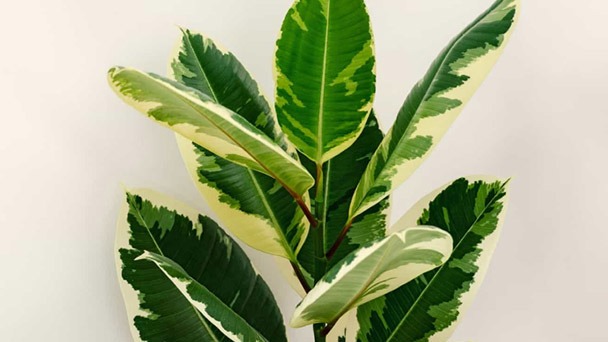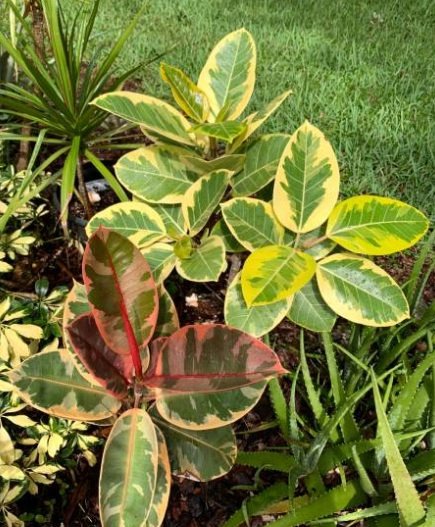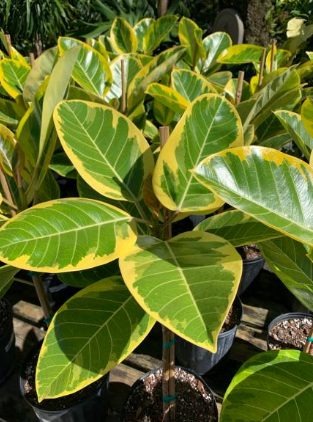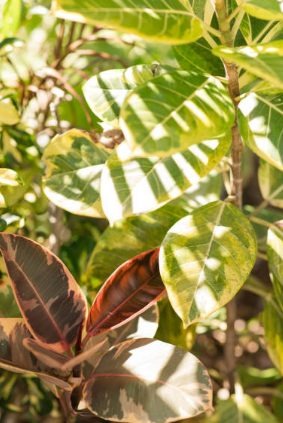Variegated Rubber Tree Plant Care & Propagation
Written by Ivy
Jan 09 2023

Regular rubber trees and variegated rubber trees have different leaf colors. Variegated rubber trees have leaves that are a variety of colors, including red, yellow, cream, and green, as opposed to traditional rubber trees' dark green leaves. They seem to be from an AirBnB in Joshua Tree. I had to have one in my house because their hues go perfectly with the desert's landscape. Here are some advice I have for keeping your variegated rubber tree healthy and happy.
Variegated Rubber Tree Plant Overview
| Botanical Name | Ficus Elastica Tineke |
| Common Names | Variegated Rubber plant, Ficus Tineke, Ficus Elastica Variegata |
| Origin | Indonesia, and India |
| Family | Moraceae |
| Plant Type | Perennial, Tree plant |
| Full Size | From 30 feet to 50 feet tall |
| Sun Exposure | Partial, Indirect Sunlight |
| Soil Type | Acidic to neutral, Well-draining soil |
| Toxicity | toxic to both children and animals. |
What Are the Different Types of Variegated Rubber Plants?

A few common types include "Tineke," which includes white on all the leaves tips; "Ruby," which has pink on all the edges of the leaves; and "Burgundy," which produces a fully dark red leaf. The natural height of this plant, which is native to South and Southeast Asia, can reach more than 40 feet.
But they'll probably be up to 10 feet inside a house. My non-variegated rubber plant is now several years old, and last year I had to prune it back. Sitting on a plant stand, it was about to hit my ceiling!
Ideal Variegated Rubber Plant Care Conditions
This unusual plant is an affordable way to add greenery and vibrant colors to your home. The amount of sunlight needed to keep the lovely leaves in their best condition is the main difference between caring for a regular rubber plant and a variegated one.
The maintenance is very similar to that of a standard rubber plant, with the exception of the need for a narrower spectrum of light. As a result, let's examine the details.
Light
Ficus Tineke care involves having access to enough bright light. The rubber plant's variegated leaves would be harmed by prolonged exposure to direct sunlight; therefore, the light intensity must be limited or indirect.
Despite preferring indirect light, the Ficus Tineke plant can benefit from a small amount of exposure to direct light for healthy growth.
By giving the rubber tree plant variety access to no more than 4 hours of direct sunlight each day, you could alternate between both sun intensities. The remainder of the day is then spent with access to indirect sunlight.
If the amount of sunlight being received is too low, the exquisite houseplant may experience stunted foliage growth and develop a sad and leggy appearance.
Keep the plant in a space with an east-facing window so it can benefit from the morning sunlight. If the sun becomes too hot, a sheer curtain can help the plant get the needed shade to survive.
Water
Prior to providing the plant with additional water, let the soil completely dry out. Simple tap water is all that is required. You should watch out that watering doesn't just drip; it should also pass through the soil and drainage holes. After giving the plant a good soak, allow it to fully dry.
The large, glossy, thick leaves of the rubber plant have the potential to attract dust. (On how to clean houseplant leaves, see my post.) I enjoy taking my rubber plants into the shower or outside on the deck to completely hose them down with a shower head or hose. It also gives the plant a good watering and cleans the leaves. Win-win.
Soil
You should pick a soil that drains well. Any soil suitable for indoor plants that drains well could be used. Look for something labeled "house-plant" or "well-draining container" soil. But if you're a little more experienced and want to make sure you're giving your variegated rubber plant the best of the best, a great suggestion for a soil recipe is 1/3 regular potting mix, 1/3 cacti soil, and 1/3 perlite.
This light, drier mixture will make it simple for your soil to completely dry out in between waterings. Currently, a large variegated rubber plant that I have is in a well-draining potting soil that already contains perlite, coco coir, or fine moss. I added one more handful of perlite to aid in drainage.
Temperature & Humidity
Rubber plants that are variegated don't need a lot of humidity. Only 20 to 30 percent is sufficient. Even when using central air conditioning or heating, that is well within the range of most household humidity levels. If your leaves do turn brown, humidity is usually not the culprit.
To provide humidity for your ficus elastica, you don't need to use a humidifier or take any special measures. Normal room temperatures will make them content. Another thing that makes it the ideal houseplant is that it requires little maintenance.
Cooler temperatures are preferable for a variegated plant since they will promote greater variegation. It is ideal to keep things between 65 and 80 degrees Fahrenheit.
Repotting
Your variegated rubber plant needs to be repotted every one to two years. It might be time for a repot if you notice roots on the surface of the soil, need to water more frequently, have smaller leaves, or notice slower growth.
To give your plant enough room when repotting, choose a pot that is 2-3 inches larger than the one you previously used. Use fresh soil to ensure that the plant receives all of the beneficial elements in the soil. This spring, when I replanted my rubber plants, I also added some worm castings for added nutrition.
Fertilizer
The Ficus plant variety grows quickly, so fertilizer feeding should be done on a regular basis. Your rubber tree plant needs to be fertilized once per month, or every three weeks.
During the summer growing season, fertilizing should be done. Since the plant would be dormant during the winter, try to avoid fertilizing as much as you can.
It is recommended to use liquid soluble fertilizers that have been diluted to about half their initial strength. The plant's soil, not its leaves, should receive the fertilizer.
It would be necessary to deep water the plant to remove any excess fertilizer residue that might remain on the soil. Before stopping, make sure the extra water has passed through the pot's base.
How to Propagate a Variegated Rubber Plant
Simply cut along the stem between a node to reproduce a variegated rubber plant. The nodes appear as lines running the length of the trunk. Generally speaking, you can cut through leaves. Rubber plant sap, which is a thick, white substance that can irritate skin, should be handled with gloves and a paper towel.
Make sure to immerse the new stem in water and give it plenty of bright light. To ensure that no bacteria harm your propagation, periodically replace the water. Planting in your well-draining potting soil is then possible once you have a root system.
You can also plant the cutting directly in the ground instead of using the water propagation stem at all. Additionally, I advise dipping the cutting in rooting hormone first. When you pull on the cutting and encounter resistance, reduce watering and continue to care for the plant as usual. Keep the soil moist while roots develop.
Common Problems You Might Face With Variegated Rubber Plants

A lot of the problems you might have with your rubber plant are related to how much light or water it is getting. Make sure the plant is in the best possible conditions by checking the light levels if you experience any of these problems.
1. Small Leaves Or No Growth
Make sure your plant is getting enough light if you notice it developing tiny leaves. If you have a southern window available, you might be able to resolve this problem by relocating your plant there. You can try adding fertilizer to hasten growth if there is absolutely no new growth and all requirements are met.
In the worst case scenario, you might decide to remove the top to promote new growth. You can see the new growth by making a cut between the nodes. Additionally, it will spread out and develop a bushier appearance, which is nice.
2. Root Rot
Root rot may develop if you water your plants excessively, don't let the soil completely dry out in between waterings, or place them in overly dense soil. Because we love them so much, I'd say that overwatering and root rot are the two biggest killers of indoor plants.
The roots might be mushy and easily break apart, and they might appear slimy and black or gray. It can be helpful to check and make sure that this isn't still stuck on the roots of your variegated rubber plant because root rot could also be caused by the root ball still being trapped by its nursery mesh material.
3. Not Enough Water Or Too Much Water
It's possible that underwatering is the cause of wrinkly, folded, and brown, drooping leaves. Brown leaves may appear if you do not let your pot dry out completely between waterings. Overwatering is probably the cause of your leaves turning yellow and dropping.
4. Cercospora
Cercospora, an ascomycete species of fungal organism, is also very susceptible to Ficus elastica.
This fungus first manifests as small, asymmetrical spots with purple borders, and it eventually causes significant leaf holes.
Care Tips & Things to Be Aware Of
Prune It into Shape
It will eventually need to be pruned because the variegated rubber plant can get up to 6 feet tall. The main thing you must choose is whether you want to be tall and slender or bushy.
Avoid cutting off the plant's top until the plant has grown to the desired height if you're after a tall rubber tree. Trim the top and side stems for a bushy appearance. From each stump, your plant has the potential to produce up to two new branches.
Remember that you can grow your rubber tree from any cuttings you take when pruning it!
Additionally, if you have leaves on the bottom that start to fall off (a natural process in which the plant sheds its oldest leaves), you can cut a tiny notch where the leaf originally came from. If you're lucky, you might see a fresh leaf emerge from this area.
One thing you'll notice is that the roots at the base of your variegated rubber tree are growing above the ground.
There is no need to be concerned because they are aerial roots that the plant grows naturally. You can either trim them down, or keep them for an au naturel vibe
Leave It Alone
The majority of rubber plant species dislike being moved. Find the best location for it once you get it home, then leave it there for at least 3 to 4 weeks before moving it again.
It already experienced a shock when you brought it home from the greenhouse, so give it some time to adjust.
They'll fare much better if left alone, so try to refrain from moving it around the house.
Keep the Leaves Clean
You can dust the leaves with a damp cloth about once a month. This is crucial for the variegated rubber plant in particular because it relies on it to produce energy and feed itself.
It will be able to absorb sunlight more effectively if the leaves are kept free of dust.
Even some people, according to what I've heard, rub a small amount of mayonnaise or banana peel on the leaves to keep them looking extra glossy.
White Spots on Leaves
Insignificant white bumps or spots may appear on the leaves of your variegated rubber plant; do not be alarmed. Lithocysts, which are just tiny cell clusters with extra calcium, are what are known as these spots.
For the ficus elastica plant, this is entirely normal.

Toxicity to Pets
If you're like me, and you've embraced the joys of being a plant and pet parent, this little heads up is for you. Every rubber plant produces a poisonous, white sap that can be fatal to pets.
Now, my dog Miley doesn't mind houseplants too much, but you know how pets can be curious about their leafy siblings.
Just be careful not to leave your variegated rubber tree anywhere where your pets might be tempted to eat it.
Conclusion
Keep a variegated rubber plant dry between waterings if you want to take good care of it. For the best potting mix, combine coarse sand, peat moss, and pine bark. Rubber plants with variegated leaves thrive in a lot of indirect light and don't have a preference for humidity levels. 40 to 50 percent relative humidity is suitable. The ideal temperature is between 15 and 21 degrees Celsius and 60 to 70 degrees Fahrenheit. For optimum growth, feed them with a high-phosphorus fertilizer once per week.
Frequently Asked Questions
What is the Suitable Pot Size for a Rubber Plant?
Make sure the pot you choose for your rubber plant has a diameter between 3 and 4 inches.How Do You Get to Ficus to Grow More Leaves?
The ficus plant should produce more leaves if it receives frequent, but advised, watering.How Much Water for a Rubber Plant?
Try watering your potted rubber plant once a week during the growing season when it comes to watering.What is a Rubber Tree Plant?
Rubber tree plants are ornamental plants with glossy, shiny leaves that have elastic qualities.How Tall Do Indoor Ficus Trees Grow?
The Ficus tree can reach heights of up to ten feet when grown indoors.Latest Updated
- Benefits of Bugleweed - 7 Science-backed Health Benefits
- Bugleweed Dangers & Side Effects - Is It Poisonous?
- How to Plant Evergreen Trees - What You Should Know
- When to Plant Evergreens - Grow Guide for Evergreen Trees
- 12 Wonderful Evergreen Shrubs for Your Garden
- 12 Popular Evergreen Plants with Pictures for Beginners
- When And How To Prune A Lilac Bush Like a Pro
- How to Grow & Care for Lilac Vine (Hardenbergia Violacea)
- Japanese Lilac Tree (Syringa Reticulata) Care & Propagation Guide
- Shumard Oak Pros and Cons - What to Know
Popular Articles
- Winter maintenance of Antirrhinum Majus
- How to Grow Terminalia Mantaly Tree
- How to Grow and Care for Crossostephium Chinense
- How to grow Antirrhinum Majus in spring
- Peristeria Elata (Dove Orchid) Profile: Info & Care Guide
- Underwatered Snake Plant (Sansevieria Trifasciata) - Signs And How To Fix
- How to Care for Brazilian Jasmine Plant (Mandevilla Sanderi)
- How to Grow & Care for Graptopetalum Purple Delight in Summer
- Rosa Chinensis (China Rose): Plant Growing & Care Tips
- How to Care for Baby Sun Rose (Aptenia Cordifolia)